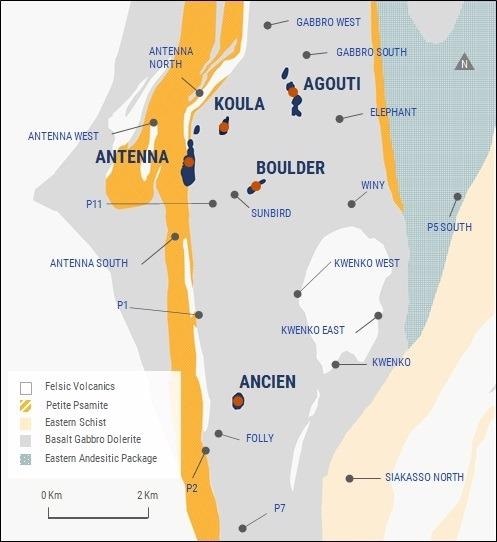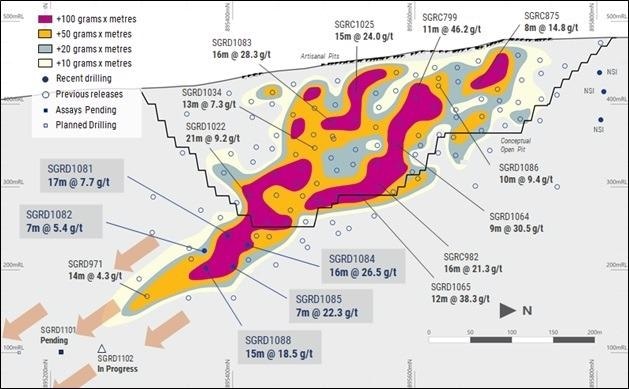Mar 10 2021
Roxgold Inc. (“Roxgold” or the “Company”) is pleased to announce assay results from down-plunge extension drilling below the high grade deposit, Koula, at the Séguéla Gold Project (“Séguéla”) located in Côte d’Ivoire.
 Figure 1. Séguéla deposits and satellite prospects. Image Credit: Business Wire
Figure 1. Séguéla deposits and satellite prospects. Image Credit: Business Wire
Séguéla gold project, côte d’ivoire
Highlights from Reverse Circulation (“RC”) and Diamond tail (“RD”) drilling
Koula
- 16 metres (“m”) at 26.5 grams per tonne gold (“g/t Au”) in drill hole SGRD1084 from 233m including
- 2m at 115.3 g/t Au from 234m and
- 1m at 24.7 g/t Au from 246m and
- 1m at 31.0 g/t Au from 248m
- 15m at 18.5 g/t Au in drill hole SGRD1088 from 256 m including
- 5m at 24.2 g/t Au from 260 m and
- 3m at 45.1 g/t Au from 268 m
- 7m at 22.3 g/t Au in drill hole SGRC1085 from 256 m including
- 1 m at 104.5 g/t Au from 261 m
- 17 m at 7.7 g/t Au in drill hole SGRD1081 from 193 m including
- 2 m at 41.6 g/t Au from 194 m and
- 1 m at 15.3 g/t Au from 206 m
“As Séguéla moves closer to a construction decision, we continue to push towards the goal of defining additional mineralization in support of our vision of Séguéla becoming a 150,000 ounce per year producer over ten plus years,” commented John Dorward, President and Chief Executive Officer of Roxgold. “The assay results today, while still early, build our confidence in the potential for Koula to conceptually extend its life via a high-grade underground operation. The strength of mineralization at depth at Koula is similar to what we were seeing at depth down-plunge in Ancien last year – a program which was temporarily put on hold in order to infill and upgrade the in-pit defined Inferred Mineral Resource at Koula for inclusion into the upcoming Feasibility study. While we had initially viewed Koula as an attractive satellite opportunity it is now clear that it has the potential to be the most important deposit defined at Séguéla so far. In addition, our drills have resumed extension testing at Ancien, the other ultra-high grade deposit discovered to date.
“We continue to believe we have only begun to tap the potential of the Séguéla Project and are eager to continue to uncover and test the wealth of additional targets present on the property. While our exploration team continues their work at Séguéla, the critical path for the Séguéla project plan is on track with the Feasibility Study scheduled for the second quarter of this year, followed soon thereafter by a construction decision towards the goal of achieving first gold pour at Séguéla in 2022.”
Paul Weedon, Vice President Exploration commented “Building off the recent high grade results from the conclusion of the infill program, these new results highlight the potential for an underground target extending down-plunge from Koula and provide a high degree of confidence in the high grades over at least 150 m down-plunge. Coupled with the 14 m at 4.3 g/t intersected in SGRD971 we see mineralization extending at least 250 m at depth and I am looking forward to the results from the next round of step-out drilling, which is testing the potential a further 120 m down-plunge.”
Koula
Located approximately 1 km to the east of Antenna, Koula was discovered through field reconnaissance and coincident recent artisanal workings in an area previously considered to be a lower exploration priority. A diamond drill rig is continuing to test for down plunge extensions to the high grade Koula mineralization, targeting the next 120 m to 150 m step-out further down plunge from the previously deepest intersection of 14 m at 4.3 g/t in SGRD971.
Mineralization is hosted by quartz-carbonate veining associated with a well developed mylonitic fabric within and along the interpreted margins of a tholeiitic basalt, with a very strong structural control evident in the association of a cross-cutting north north-east trending structure. This mylonitic zone can be traced for several kilometres along strike on the regional magnetics and looks to also be associated with the mineralization at Ancien, some 6km to the south.

Figure 2. Koula assay results and assay status
Highlights from the most recent phase of the Indicated infill drilling program at Koula include:
- 16 metres (“m”) at 26.5 grams per tonne gold (“g/t Au”) in drill hole SGRD1084 from 233 m including
- 2 m at 115.3 g/t Au from 234 m and
- 1 m at 24.7 g/t Au from 246 m and
- 1 m at 31.0 g/t Au from 248 m
- 15 m at 18.5 g/t Au in drill hole SGRD1088 from 256 m including
- 5 m at 24.2 g/t Au from 260 m and
- 3 m at 45.1 g/t Au from 268 m
- 7 m at 22.3 g/t Au in drill hole SGRC1085 from 256 m including
- 1 m at 104.5 g/t Au from 261 m
- 17 m at 7.7 g/t Au in drill hole SGRD1081 from 193 m including
- 2 m at 41.6 g/t Au from 194 m and
- 1 m at 15.3 g/t Au from 206 m
- 7m at 5.4 g/t Au in drill hole SGRC1082 from 233 m including
- 1m at 29.0 g/t Au from 235 m
Catalysts and next steps
|
Event
|
Timing
|
|
Ongoing infill, expansion and satellite target drilling program at Séguéla
|
Q2 2021
|
|
District exploration drill results at Yaramoko
|
Q2 2021
|
|
Underground drilling program in 55 Zone at Yaramoko Mine Complex
|
Q2 2021
|
|
Boussoura exploration results
|
Q2 2021
|
|
Feasibility Study for Séguéla
|
Q2 2021
|
|
Séguéla construction decision
|
H1 2021
|
|
Initial resource at Boussoura
|
H1 2021
|
|
Commissioning of Séguéla Gold Project
|
H1 2021
|
Quality assurance/quality control
All drilling data completed by Roxgold utilized the following procedures and methodologies. All drilling was carried out under the supervision of Roxgold personnel.
RC drilling used a 5.25 inch face sampling pneumatic hammer with samples collected into 60 litre plastic bags. Samples were kept dry by maintaining enough air pressure to exclude groundwater inflow. If water ingress exceeded the air pressure, RC drilling was stopped, and drilling converted to diamond core tails. Aircore (“AC”) drilling was collected in one metre intervals and sampled in a similar fashion to RC methods. Once collected, RC and AC samples were riffle split through a three-tier splitter to yield a 12.5% representative sample for submission to the analytical laboratory. The residual 87.5% sample were stored at the drill site until assay results were received and validated. Coarse reject samples for all mineralized samples corresponding to significant intervals are retained and stored on-site at the Company controlled core yard.
DD drill holes were drilled with HQ sized diamond drill bits. The core was logged, marked up for sampling using standard lengths of one metre. Samples were then cut into equal halves using a diamond saw. One half of the core was left in the original core box and stored in a secure location at the Company core yard at Séguéla. The other half was sampled, catalogued and placed into sealed bags and securely stored at the site until shipment.
All Séguéla RC, AC and DD core samples were shipped to ALS Laboratories preparation laboratory in Yamoussoukro for preparation. Samples were dried and crushed by the Lab and a 250-gram split prepared from the coarse crushed material, prior to pulverization and preparation of a 200g sample. Samples are then shipped via commercial courier to ALS’s analytical facility in Ouagadougou, Burkina Faso where routine gold analysis using a 50-gram charge and fire assay with an atomic absorption finish was completed. Quality control procedures included the systematic insertion of blanks, duplicates and sample standards into the sample stream. In addition, the Lab inserted its own quality control samples.
For more information on the Company’s QA/QC and sampling procedures, please refer to the Company’s Annual Information Form for the year ended December 31, 2019, available on the Company’s website at: www.roxgold.com and on SEDAR at: www.sedar.com.
Qualified Person
Paul Weedon, MAIG, Vice-President, Exploration for Roxgold Inc., a Qualified Person within the meaning of National Instrument 43-101, has reviewed and approved the scientific and technical disclosure contained in this news release, including the QA/QC, sampling, analytical and test data underlying this information. Mr. Weedon verified the information in the news release by reviewing the drill logs, geological interpretations and supporting analytical data. No limitations were imposed on Mr. Weedon’s verification process.
Roxgold’s disclosure of Mineral Reserve and Mineral Resource information is governed by NI 43-101 and under the guidelines set out in the Canadian Institute of Mining, Metallurgy and Petroleum (“CIM”) Standards on Mineral Resources and Mineral Reserves, adopted by the CIM Council, as may be amended from time to time by the CIM. There can be no assurance that those portions of Mineral Resources that are not Mineral Reserves will ultimately be converted into Mineral Reserves.
For more information on the Séguéla Gold Project please refer to the Company press release titled “Roxgold Increases Indicated Mineral Resources by 97% to Over 1 Million Ounces at Séguéla; Reports Maiden Inferred Mineral Resource at Koula of 281,000 oz at 8.1 gpt Au” dated December 14, 2020; and the Company’s technical report entitled “NI 43-101 Technical Report, Séguéla Project, Preliminary Economic Assessment, Worodougou Region, Cote d’Ivoire” dated April 14, 2020, each available on the Company’s website at www.roxgold.com and SEDAR at www.sedar.com.